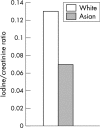Prevalence of maternal dietary iodine insufficiency in the north east of England: implications for the fetus
- PMID: 15321965
- PMCID: PMC1721745
- DOI: 10.1136/adc.2003.029306
Prevalence of maternal dietary iodine insufficiency in the north east of England: implications for the fetus
Abstract
Background: Maternal subclinical hypothyroidism is a cause of poor neurodevelopment outcome in the offspring. Although iodine deficiency is the most common cause of hypothyroidism world wide, there are no screening programmes for it in the United Kingdom where the population is assumed to be iodine replete.
Objective: To determine the prevalence of reduced iodine intake by measuring urinary iodide concentrations in pregnant and non-pregnant women from the north east of England.
Methods: Urinary iodide excretion (UIE) rate was estimated using inductively coupled mass spectrometry in 227 women at 15 weeks gestation and in 227 non-pregnant age matched controls. A reduced intake of iodine is indicated by a concentration in urine of less than 50 microg/l or less than 0.05 microg iodine/mmol creatinine.
Results: Eight (3.5%) pregnant women and 13 (5.7%) controls had a reduced iodine/creatinine ratio. These values were higher when UIE was expressed as iodine concentration: 16 (7%) and 20 (8.8%) respectively. Ninety (40%) of the pregnant women had a UIE of 0.05-0.10, which is consistent with borderline deficiency.
Conclusion: In this study, 3.5% of pregnant women had evidence of iodine deficiency, and 40% may be borderline deficient. Larger scale studies are required to estimate the true prevalence of iodine deficiency in the United Kingdom.
Figures
Similar articles
-
Iodine deficiency in pregnant women residing in an area with adequate iodine intake.Nutrition. 2008 May;24(5):458-61. doi: 10.1016/j.nut.2008.01.015. Epub 2008 Mar 12. Nutrition. 2008. PMID: 18337060
-
Iodine deficiency disorder among pregnant women in a tertiary care hospital of Kolkata, India.Southeast Asian J Trop Med Public Health. 2010 Jul;41(4):989-95. Southeast Asian J Trop Med Public Health. 2010. PMID: 21073075
-
[Reflections on mental retardation and congenital hypothyroidism: effects of trace mineral deficiencies].Sante. 2007 Jan-Mar;17(1):41-50. Sante. 2007. PMID: 17897901 Review. French.
-
Iodine deficiency in Europe and its consequences: an update.Eur J Nucl Med Mol Imaging. 2002 Aug;29 Suppl 2:S404-16. doi: 10.1007/s00259-002-0812-7. Epub 2002 Jun 1. Eur J Nucl Med Mol Imaging. 2002. PMID: 12192540 Review.
-
The Urine Iodine to Creatinine as an Optimal Index of Iodine During Pregnancy in an Iodine Adequate Area in China.J Clin Endocrinol Metab. 2016 Mar;101(3):1290-8. doi: 10.1210/jc.2015-3519. Epub 2016 Jan 20. J Clin Endocrinol Metab. 2016. PMID: 26789777
Cited by
-
The changing epidemiology of iodine deficiency.Nat Rev Endocrinol. 2012 Apr 3;8(7):434-40. doi: 10.1038/nrendo.2012.43. Nat Rev Endocrinol. 2012. PMID: 22473332 Review.
-
2014 European thyroid association guidelines for the management of subclinical hypothyroidism in pregnancy and in children.Eur Thyroid J. 2014 Jun;3(2):76-94. doi: 10.1159/000362597. Epub 2014 Jun 7. Eur Thyroid J. 2014. PMID: 25114871 Free PMC article.
-
A review of the iodine status of UK pregnant women and its implications for the offspring.Environ Geochem Health. 2015 Aug;37(4):619-29. doi: 10.1007/s10653-015-9682-3. Epub 2015 Feb 7. Environ Geochem Health. 2015. PMID: 25663363 Free PMC article. Review.
-
Optimising outcome in congenital hypothyroidism; current opinions on best practice in initial assessment and subsequent management.J Clin Res Pediatr Endocrinol. 2013;5 Suppl 1(Suppl 1):13-22. doi: 10.4274/jcrpe.849. Epub 2012 Nov 15. J Clin Res Pediatr Endocrinol. 2013. PMID: 23154163 Free PMC article. Review.
-
Doubts and Concerns about Isolated Maternal Hypothyroxinemia.J Thyroid Res. 2011;2011:463029. doi: 10.4061/2011/463029. Epub 2011 Jun 15. J Thyroid Res. 2011. PMID: 21765991 Free PMC article.
References
MeSH terms
Substances
LinkOut - more resources
Full Text Sources
Medical




